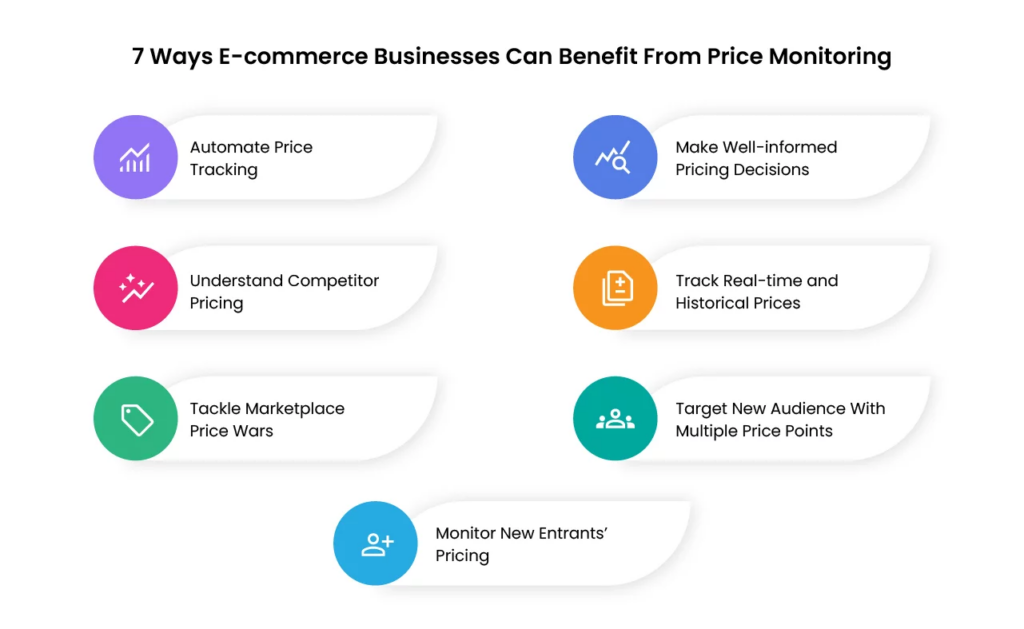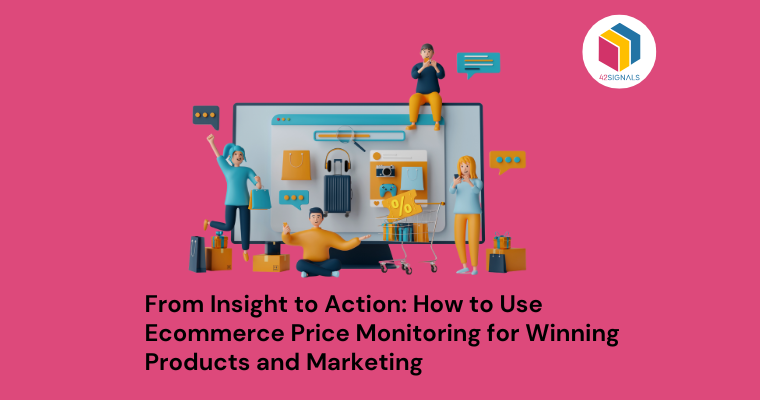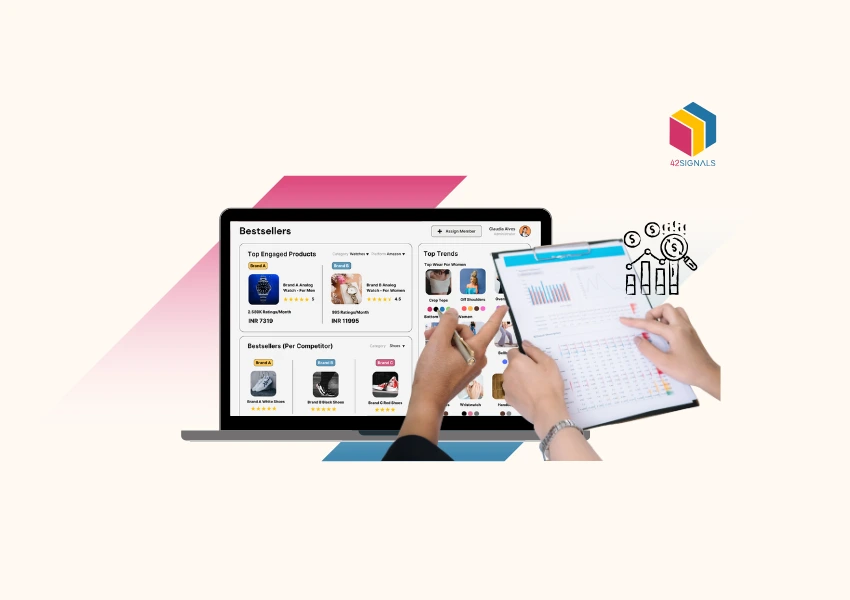Data is the crux of all businesses today and to stay on top, companies need to make informed decisions based on data-driven insights. One such valuable intel comes from ecommerce price monitoring – a powerful tool that provides valuable information about your competitors’ pricing strategies, market trends, and customer behavior.
Let’s explore how you can use it to optimize product selection, enhance marketing efforts, and boost sales.
What is ECommerce Price Monitoring?
E-commerce price monitoring involves tracking and analyzing the prices of products sold online by various retailers. This process helps businesses gain insights into their competitors’ pricing tactics, identify market trends, and adjust their pricing strategy accordingly.

Image Source: Price2Spy
By continuously monitoring prices, businesses can ensure they remain competitive while maximizing profits.
Benefits of Price Monitoring

Image Source: Kanhasoft
Improved Product Selection
With access to real-time pricing data, businesses can identify popular products with high demand but low competition. This knowledge allows them to focus on carrying winning items that appeal to customers and differentiate them from rivals.
Competitive Advantage
Staying updated on competitors’ pricing enables businesses to react swiftly when necessary, ensuring they don’t lose potential customers due to outdated or inappropriate pricing.
Enhanced Customer Experience
Knowing what prices consumers are willing to pay for specific products helps companies tailor their offerings and promotions to meet those expectations, leading to increased satisfaction and loyalty.
Better Decision Making
Armed with accurate and timely information from ecommerce price monitoring, decision-makers can make well-informed choices regarding product assortment, pricing, and promotion, ultimately driving growth and profitability.
How to Implement Effective Price Monitoring?
1. Define Your Goals
Clearly outline what you hope to achieve through price monitoring (e.g., improving product selection, increasing competitiveness, enhancing customer experience). Having clear objectives will guide your approach and help measure success.
2. Select the Right Tools
Invest in reliable and efficient ecommerce price monitoring software that suits your needs. Look for features like real-time updates, customizable alerts, comprehensive data analysis, and integration capabilities with existing systems. Some popular options include Prisync, Algopix, and 42Signals.
3. Identify Key Competitors
Determine who your direct and indirect competitors are and monitor their pricing closely. Pay attention to both local and global players within your industry niche. Remember that competitors may change over time as new businesses enter the market or existing ones shift focus.
4. Analyze Market Trends
Regularly review pricing patterns across categories and regions to understand broader market dynamics. Identify any seasonal fluctuations, emerging trends, or shifts in consumer preferences that could impact your business.
5. Adjust Pricing Strategy
Based on your findings, modify your pricing strategy to maintain competitiveness without compromising margins. Consider implementing dynamic pricing models that automatically adjust prices according to predefined rules and triggers.
6. Optimize Product Assortment
Leverage e-commerce price monitoring insights to refine your product range, focusing on items with strong demand and favorable pricing opportunities. Continuously evaluate which products contribute most significantly to revenue and profitability.
7. Enhance Marketing Efforts
Use price monitoring data to inform targeted marketing campaigns, promotions, and messaging. For example, if you notice a competitor discounting certain products heavily during a particular period, consider launching counteroffers or highlighting unique selling points to attract customers.
8. Measure Success
Track key performance indicators (KPIs) related to your goals, such as conversion rates, average order value, and market share. Regularly analyze these metrics to determine whether your price monitoring efforts are yielding desired results and adjust course accordingly.
An Example of a Consumer Electronics Company
Let’s take an example of a mid-sized e-commerce company called “TechGadgets” specializing in consumer electronics. They want to leverage price monitoring to optimize their product selection, enhance marketing efforts, and boost sales. Here’s how they might implement each step:
Define Goals
TechGadgets wants to improve its product mix, become more competitive in terms of pricing, and provide better deals for customers compared to major competitors like Best Buy and Amazon.
Select the Right Tools
After evaluating several options, TechGadgets chose 42Signals as their price monitoring solution because it offers real-time updates, customizable alerts, detailed analytics, and seamless integration with their current inventory management system.
Identify Key Competitors
TechGadgets identifies BestBuy and Amazon as direct competitors. Additionally, they recognize NewEgg and B&H Photo Video as indirect competitors worth monitoring.
Analyze Market Trends
Using 42Signals’ ecommerce price monitoring feature, TechGadgets tracks daily price changes across multiple categories and regions. They discover that smartphones and headphones are particularly volatile markets where aggressive pricing dominates. Moreover, there’s growing interest in sustainable tech products, prompting TechGadgets to expand their eco-friendly device lineup.
Adjust Pricing Strategy
To compete effectively, TechGadgets implements dynamic pricing using 42Signals API integrations. The platform monitors competitors’ prices and provides TechGadgets with timely updates, maintaining competitiveness while preserving margin targets.
Optimize Product Assortment
Upon identifying top-performing categories and underrepresented niches, TechGadgets introduces new product lines focused on smartphones, headphones, and eco-friendly devices. Simultaneously, they phase out slow-moving items with limited growth prospects.
Enhance Marketing Efforts
Equipped with competitor pricing intel, TechGadgets launches targeted email campaigns promoting exclusive deals and bundles featuring highly demanded items at attractive price points. These efforts drive traffic and conversions, further solidifying TechGadgets’ position in the market.
Measure Success
Over six months, TechGadgets observes notable improvements in KPIs like conversion rate (up 15%), average order value ($10 higher than previous periods), and market share (increased by 3 percentage points).
Conclusion
These steps as detailed above show the benefits of an ecommerce price monitoring platform which helps improve product selection, strengthen marketing initiatives, and ultimately increase sales and profitability.
If you are on the lookout for software that helps you keep track of your competitor’s prices, schedule a demo with 42Signals today.







